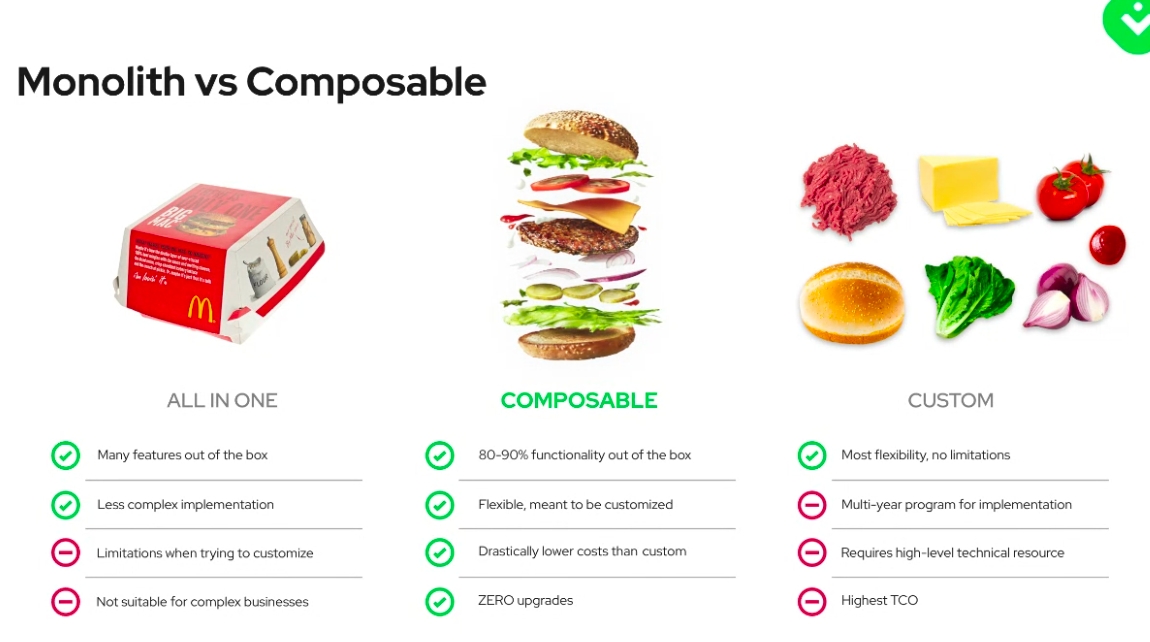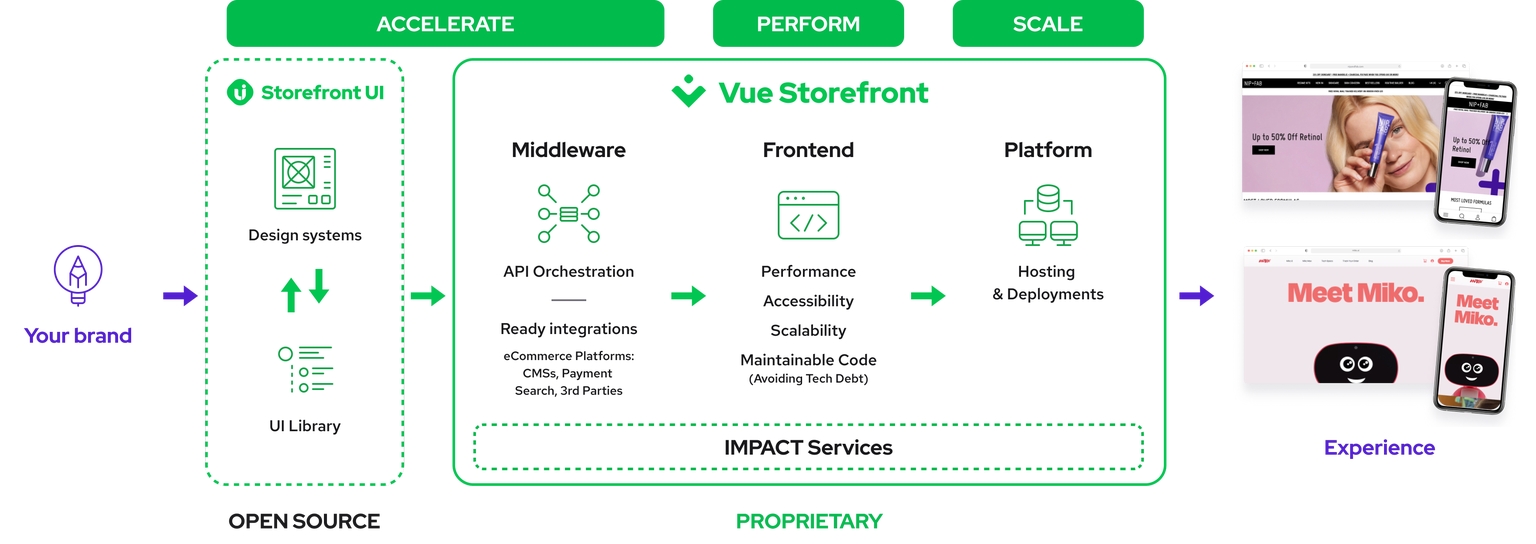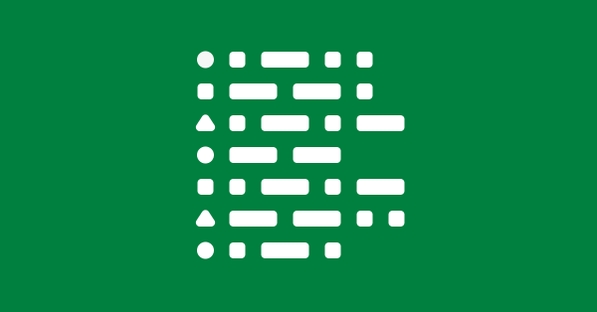Embracing headless architecture can unlock an unparalleled competitive advantage for eCommerce vendors, yet only if you understand its full potential.
Luckily, this article covers just that! We’ll go over all the essentials, including:
the definition of composable commerce;
the benefits of composable commerce for SAP Commerce Cloud users;
how you can go composable without re-platforming;
why you should begin your composable journey with frontend-as-a-service (FaaS), and more!
So let's start with the elephant in the room:
What is composable commerce?
Composable commerce builds on the concept of headless commerce, where the frontend and backend of a web store are decoupled, giving businesses greater flexibility, scalability, and control.
Unlike traditional eCommerce models (also commonly referred to as "monolith"), composable commerce is modular and agile. It enables businesses to quickly and easily update and customize their web store to meet their customers’ ever-changing needs.

With composable commerce, you can take advantage of the latest technologies and services to deliver a seamless, personalized experience to your customers via the best-of-breed solutions without jeopardizing your backend performance.
Benefits of going headless
SAP Commerce Cloud users can benefit greatly from composable commerce, as it offers a suite of powerful tools to improve their omnichannel retail strategy. Here are some of the advantages:
Faster time-to-market - Separate development cycles for a functional layer and a presentation layer make it feasible to quickly adapt to market changes by running tests and introducing extra features.
Scalability - Decoupling your store makes it easier to scale up or down to meet your customers’ demand levels. Additionally, the system can be quickly augmented through technology-agnostic integrations of third-party modules.
Fast web performance - Websites can be incredibly fast with a decoupled system, where the frontend and backend are connected through an API. This makes page loading faster and more efficient, greatly improving web performance.
Personalized customization - You can adjust the system to your exact business needs, facilitating an ideal customer experience.
Enhanced security - Decoupled layers only make the frontend accessible to the public, while the backend remains hidden, offering enhanced security of personal data.
How headless commerce affects customer experience
Going composable unlocks a wide range of benefits on the user end as well! Most notably, it allows for the integration of the best-of-breed solutions for key interactions and experiences.
Personalized product recommendations make users more likely to come back and purchase from the store once again, with personalization being a crucial factor in the success of an eCommerce business.
Multi-channel interactions become easier as composable commerce facilitates the integration of various touchpoints (web, mobile, social, in-store).
Improved checkout and customer support experience is achieved through embedding customizable components from the best-of-class providers.
More products and suppliers become available thanks to the facilitated integration with multiple various vendors.
Enhanced data security occurs thanks to the modular nature of composable commerce that allows for the integration of the latest security solutions.
Potential drawbacks of embracing composable commerce
At the same time, there are certain limitations you'd be wise to keep in mind when it comes to adopting the headless approach for your eCommerce operations.
Initial expenses: Since headless platforms don't provide a complete product, the launching of distinct projects for frontend construction and other systems integration could prolong the time needed to reach the desired outcome.
More complex control needed: You have fewer possibilities for content display and presentation with a headless platform, so other services might be required for certain operations.
Going headless with SAP Commerce Cloud
SAP Commerce Cloud is a powerful headless commerce platform helping enterprises navigate the dynamic world of digital retail. It is designed to support complex B2B, B2C, and B2B2C scenarios, enabling businesses to manage digital commerce operations efficiently and scale as needed.
Is SAP Commerce Cloud headless?
SAP Commerce Cloud allows for some headless eCommerce scenarios through its API-first approach, and you can unlock the composable storefront layer of the SAP ecosystem via its integration with the JS-based storefront layer, Spartacus.
Yet, it's worth mentioning that you will still be struggling with multiple limitations, thus not fully embracing all the benefits a truly headless architecture brings to the table.
Key SAP Commerce Cloud features
SAP CC provides its clients with a powerful engine for understanding their customers and connecting with them by delivering high-quality shopping experiences. Some of the most noteworthy features include:
Omni Commerce Connect: OCC API allows you to integrate SAP CC's full range of functionalities across different touchpoints of your existing processes and to add processes to new interfaces.
Microservices-based solution: SAP Commerce Cloud microservices are constructed around the platform, enhancing and extending its capabilities.
Unified commerce dashboard for core capabilities: Product content management, multilingual and multicurrency catalogs, experience, and order management – all are available at once.
Pre-built integrations: SAP CC is integrated with SAP ERP, SAP S/4HANA, as well as multiple third-party systems for more capabilities.
How to go headless with SAP CC without re-platforming
Many businesses try to avoid re-platforming at all costs because of, well, the costs.
A full re-platforming is a complicated, multi-stage endeavor that can take up to a year. This process has two parts: developing a fresh composable stack distinct from your current commerce system, then moving your data and transitioning when it is tested and working. There are many reasons why it's less than ideal:
High initial outlay: You have to take into account the expenses of a new eCommerce platform, frontend solution, headless CMS, and other composable tools. On top of that, adding the cost of development, hosting, and regular maintenance significantly increases the original investment.
Extended return on investment: Due to the long development cycle and high original costs of full re-platforming, you will have to wait a number of months to see if the investment is profitable.
Challenging implementation: A fully developed eCommerce company with well-planned operations may come across many difficulties while performing both frontend and backend re-platforming at the same time.
But what if it didn't have to be the case?
Going composable within SAP Commerce Cloud Architecture with the FaaS approach
There is no need to replace your reliable eCommerce solution to benefit from the competitive advantage unlocked through headless commerce. All you have to do is to focus on the user side of things first, and consider updating your backend later. Here's what it means exactly.
What is Frontend as a Service?
Frontend as a Service is an effective way of developing a frontend for a website that allows for a user-friendly, attractive, and fast frontend that is customizable with a single tool. This reduces the amount of time and money invested, resulting in a more powerful digital customer experience that can be implemented from the start.

Thanks to the already-available core elements for frontend development, developers can create a mobile-friendly and performant frontend layer in a significantly shorter amount of time, instead of having to construct it from the very beginning.
Why should headless commerce be frontend-first?
The frontend of an eCommerce website is the most important part of an online business. It is the user interface that all promotional activities lead to, and it is the first chance to attract and impress shoppers when they arrive on the website. Your storefront is often the key factor in their selection to buy.
As the customer's journey happens on the frontend, you need to ensure your storefront architecture is optimized for delivering top-notch customer experiences.
However, merely investing in a range of costly point solutions will not suffice. Poor architecture can result in slow loading speeds, slow indexing, and poor customer experience, and these problems cannot be solved just by using third-party tools to increase conversion at specific touchpoints.
Thus, it is better to build a new frontend foundation that is optimized for speed and mobile rather than just plugging the holes.
Best storefronts for SAP Commerce Cloud
If you initiate your transformation with Frontend as a Service, which offers ready, pre-constructed, and highly adjustable components and integrations, you can avoid custom development and attach a powerful frontend on top of your current SAP Commerce Cloud software without expensive and drawn-out re-platforming.
That's where storefront tech comes in.
SAP CC, Composable Storefront (formerly Spartacus)
For years, Spartacus was a popular choice with many SAP customers. However, lately, the solution has been lagging. Some of the main reasons it has never quite grew outside of the SAP ecosystem include:
Lack of flexibility in customization;
A steep learning curve;
Monolithic design restricting integrations to the SAP ecosystem.
It may be challenging to integrate Spartacus with a modern CMS or incorporate the latest trending eCommerce features unless they are already a part of your SAP CC.
So if you are only considering selecting the storefront solution for SAP Commerce Cloud, we may have a better alternative for you – Alokai.
Alokai for SAP CC
With 50+ pre-built UI components, pre-made frontend architecture, and multiple out-of-the-box integrations with popular eCommerce solutions, including SAP Commerce Cloud, Alokai will help you along, reducing the total cost of ownership and speeding up time-to-market.
The new pre-composed solution from Alokai and SAP Commerce Cloud makes it easy to start a composable commerce transformation.
This setup eliminates the need for re-platforming, allowing merchants to enjoy a lightning-fast frontend with your existing backend capabilities. By doing so, you can achieve increased revenue and improved customer experience from the outset without the tremendous effort and cost associated with a full migration.

















